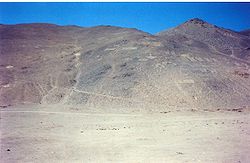
Pampa del Tamarugal National Reserve
Encyclopedia

Nature reserve
A nature reserve is a protected area of importance for wildlife, flora, fauna or features of geological or other special interest, which is reserved and managed for conservation and to provide special opportunities for study or research...
of northern Chile
Chile
Chile ,officially the Republic of Chile , is a country in South America occupying a long, narrow coastal strip between the Andes mountains to the east and the Pacific Ocean to the west. It borders Peru to the north, Bolivia to the northeast, Argentina to the east, and the Drake Passage in the far...
's Tarapacá Region
Tarapacá Region
The I Tarapacá Region is one of Chile's 15 first order administrative divisions. It borders the Chilean Arica and Parinacota Region to the north, Bolivia's Oruro Department on the east, the Antofagasta Region on the south and the Pacific Ocean on the west. The port city of Iquique The I Tarapacá...
located in the Pampa del Tamarugal
Pampa del Tamarugal
Pampa del Tamarugal is a vast plain encompassing a significant portion of the Norte Grande, Chile, and originally named for the Prosopis tamarugo trees that used to cover its surface. It is located between the parallels 19°30’ and 22°15’ south latitude and is considered part of the Atacama Desert...
, about 70 km (43 mi) east of Iquique
Iquique
Iquique is a port city and commune in northern Chile, capital of both the Iquique Province and Tarapacá Region. It lies on the Pacific coast, west of the Atacama Desert and the Pampa del Tamarugal. It had a population of 216,419 as of the 2002 census...
.
The reserve consists of three separate sectors: Zapiga, Bosque Nativo de La Tirana, and Pintados. The major highlights are the forests of the genus Prosopis
Prosopis
Prosopis is a genus of flowering plants in the pea family, Fabaceae. It contains around 45 species of spiny trees and shrubs found in subtropical and tropical regions of the Americas, Africa, Western Asia, and South Asia. They often thrive in arid soil and are resistant to drought, on occasion...
(primarily Prosopis tamarugo
Prosopis tamarugo
Prosopis tamarugo, commonly known as the Tamarugo, is a species of flowering tree in the pea family, Fabaceae. It is only found in northern Chile, particularly in the Pampa del Tamarugal, some east of the city of Iquique. This bushy tree apparently grows without the benefit of rainfall, and...
), found in the middle of a rainless desert, and the Pintados geoglyph
Geoglyph
A geoglyph is a large design or motif produced on the ground and typically formed by clastic rocks or similarly durable elements of the geography, such as stones, stone fragments, gravel, or earth...
s.
The total protected area extends on more than 102,264 hectares.
The sectors of Zapiga and Pintados are crossed by the Pan-American Highway
Pan-American Highway
The Pan-American Highway is a network of roads measuring about in total length. Except for an rainforest break, called the Darién Gap, the road links the mainland nations of the Americas in a connected highway system. According to Guinness World Records, the Pan-American Highway is the world's...
and Sector Bosque Nativo de La Tirana can be accessed from A-665 Route.

